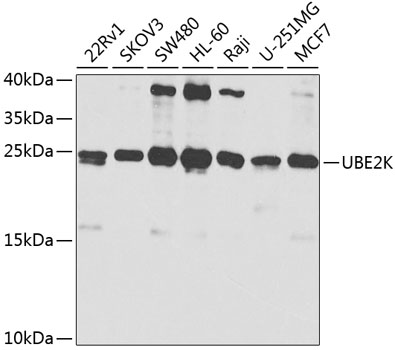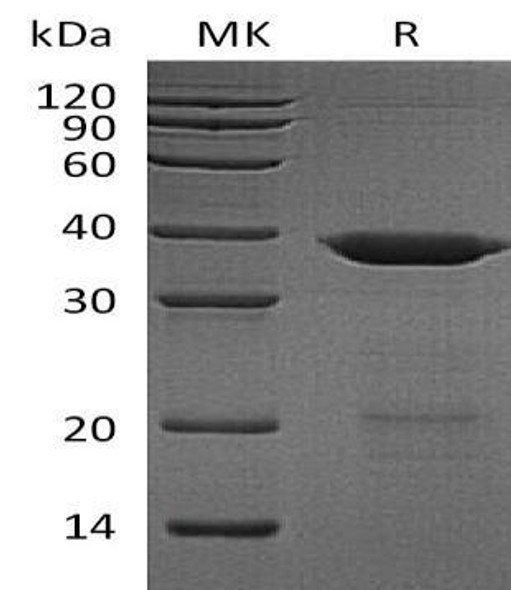Signal Transduction Antibodies 1
Anti-UBE2K Antibody (CAB1086)
- SKU:
- CAB1086
- Product Type:
- Antibody
- Reactivity:
- Human
- Reactivity:
- Mouse
- Reactivity:
- Rat
- Host Species:
- Rabbit
- Isotype:
- IgG
- Antibody Type:
- Polyclonal Antibody
- Research Area:
- Signal Transduction
Description
| Antibody Name: | Anti-UBE2K Antibody |
| Antibody SKU: | CAB1086 |
| Antibody Size: | 20uL, 50uL, 100uL |
| Application: | WB |
| Reactivity: | Human, Mouse, Rat |
| Host Species: | Rabbit |
| Immunogen: | A synthetic peptide corresponding to a sequence within amino acids 1-100 of human UBE2K (NP_005330.1). |
| Application: | WB |
| Recommended Dilution: | WB 1:500 - 1:2000 |
| Reactivity: | Human, Mouse, Rat |
| Positive Samples: | 22Rv1, SKOV3, SW480, HL-60, Raji, U-251MG, MCF7 |
| Immunogen: | A synthetic peptide corresponding to a sequence within amino acids 1-100 of human UBE2K (NP_005330.1). |
| Purification Method: | Affinity purification |
| Storage Buffer: | Store at -20'C. Avoid freeze / thaw cycles. Buffer: PBS with 0.02% sodium azide, 50% glycerol, pH7.3. |
| Isotype: | IgG |
| Sequence: | MANI AVQR IKRE FKEV LKSE ETSK NQIK VDLV DENF TELR GEIA GPPD TPYE GGRY QLEI KIPE TYPF NPPK VRFI TKIW HPNI SSVT GAIC LDIL KDQW |
| Gene ID: | 3093 |
| Uniprot: | P61086 |
| Cellular Location: | Cytoplasm |
| Calculated MW: | 16kDa/17kDa/22kDa |
| Observed MW: | 22kDa |
| Synonyms: | UBE2K, E2-25K, HIP2, HYPG, LIG, UBC1 |
| Background: | The protein encoded by this gene belongs to the ubiquitin-conjugating enzyme family. This protein interacts with RING finger proteins, and it can ubiquitinate huntingtin, the gene product for Huntington's disease. Known functions for this protein include a role in aggregate formation of expanded polyglutamine proteins and the suppression of apoptosis in polyglutamine diseases, a role in the dislocation of newly synthesized MHC class I heavy chains from the endoplasmic reticulum, and involvement in foam cell formation. Multiple transcript variants encoding different isoforms have been identified for this gene. |
| UniProt Protein Function: | UBE2K: Accepts ubiquitin from the E1 complex and catalyzes its covalent attachment to other proteins. In vitro, in the presence or in the absence of BRCA1-BARD1 E3 ubiquitin-protein ligase complex, catalyzes the synthesis of 'Lys-48'-linked polyubiquitin chains. Does not transfer ubiquitin directly to but elongates monoubiquitinated substrate protein. Mediates the selective degradation of short-lived and abnormal proteins, such as the endoplasmic reticulum-associated degradation (ERAD) of misfolded lumenal proteins. Ubiquitinates huntingtin. May mediate foam cell formation by the suppression of apoptosis of lipid-bearing macrophages through ubiquitination and subsequence degradation of p53/TP53. Proposed to be involved in ubiquitination and proteolytic processing of NF-kappa-B; in vitro supports ubiquitination of NFKB1. In case of infection by cytomegaloviruses may be involved in the US11-dependent degradation of MHC class I heavy chains following their export from the ER to the cytosol. In case of viral infections may be involved in the HPV E7 protein- dependent degradation of RB1. Interacts with RNF138/NARF. Interacts with BRCA1. By aggregated low-density lipoprotein. Expressed in all tissues tested, including spleen, thymus, prostate, testis, ovary, small intestine, colon, peripheral blood leukocytes, T-lymphocytes, monocytes, granulocytes and bone marrow mononuclear cells. Highly expressed in brain, with highest levels found in cortex and striatum and at lower levels in cerebellum and brainstem. Belongs to the ubiquitin-conjugating enzyme family. 2 isoforms of the human protein are produced by alternative splicing. |
| UniProt Protein Details: | Protein type:Ubiquitin ligase; Ligase; Ubiquitin conjugating system; EC 6.3.2.19 Chromosomal Location of Human Ortholog: 4p14 Cellular Component: intermediate filament cytoskeleton; cytoplasm; nucleus; actin cytoskeleton Molecular Function:protein binding; small conjugating protein ligase activity; ubiquitin protein ligase binding; ubiquitin-protein ligase activity; ATP binding; ligase activity Biological Process: ubiquitin-dependent protein catabolic process; proteasomal ubiquitin-dependent protein catabolic process; regulation of proteasomal ubiquitin-dependent protein catabolic process |
| NCBI Summary: | The protein encoded by this gene belongs to the ubiquitin-conjugating enzyme family. This protein interacts with RING finger proteins, and it can ubiquitinate huntingtin, the gene product for Huntington's disease. Known functions for this protein include a role in aggregate formation of expanded polyglutamine proteins and the suppression of apoptosis in polyglutamine diseases, a role in the dislocation of newly synthesized MHC class I heavy chains from the endoplasmic reticulum, and involvement in foam cell formation. Multiple transcript variants encoding different isoforms have been identified for this gene. [provided by RefSeq, Jul 2008] |
| UniProt Code: | P61086 |
| NCBI GenInfo Identifier: | 46577658 |
| NCBI Gene ID: | 3093 |
| NCBI Accession: | P61086.3 |
| UniProt Related Accession: | P61086 |
| Molecular Weight: | |
| NCBI Full Name: | Ubiquitin-conjugating enzyme E2 K |
| NCBI Synonym Full Names: | ubiquitin conjugating enzyme E2 K |
| NCBI Official Symbol: | UBE2K |
| NCBI Official Synonym Symbols: | LIG; HIP2; HYPG; UBC1; E2-25K |
| NCBI Protein Information: | ubiquitin-conjugating enzyme E2 K |
| UniProt Protein Name: | Ubiquitin-conjugating enzyme E2 K |
| UniProt Synonym Protein Names: | Huntingtin-interacting protein 2; HIP-2; Ubiquitin carrier protein; Ubiquitin-conjugating enzyme E2-25 kDa; Ubiquitin-conjugating enzyme E2(25K); Ubiquitin-conjugating enzyme E2-25K; Ubiquitin-protein ligase |
| Protein Family: | High-potential iron-sulfur protein |
| UniProt Gene Name: | UBE2K |
| UniProt Entry Name: | UBE2K_HUMAN |
View AllClose







